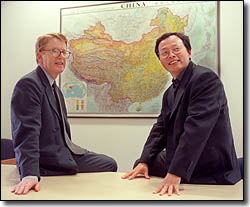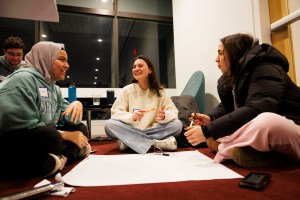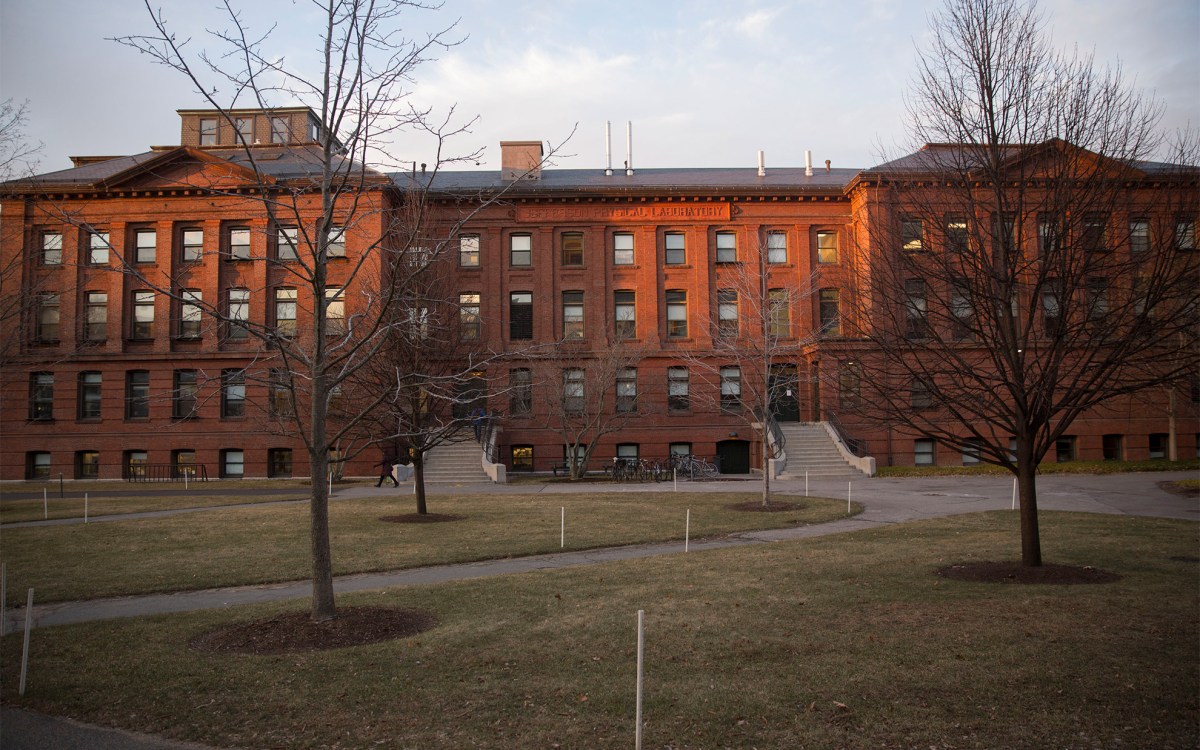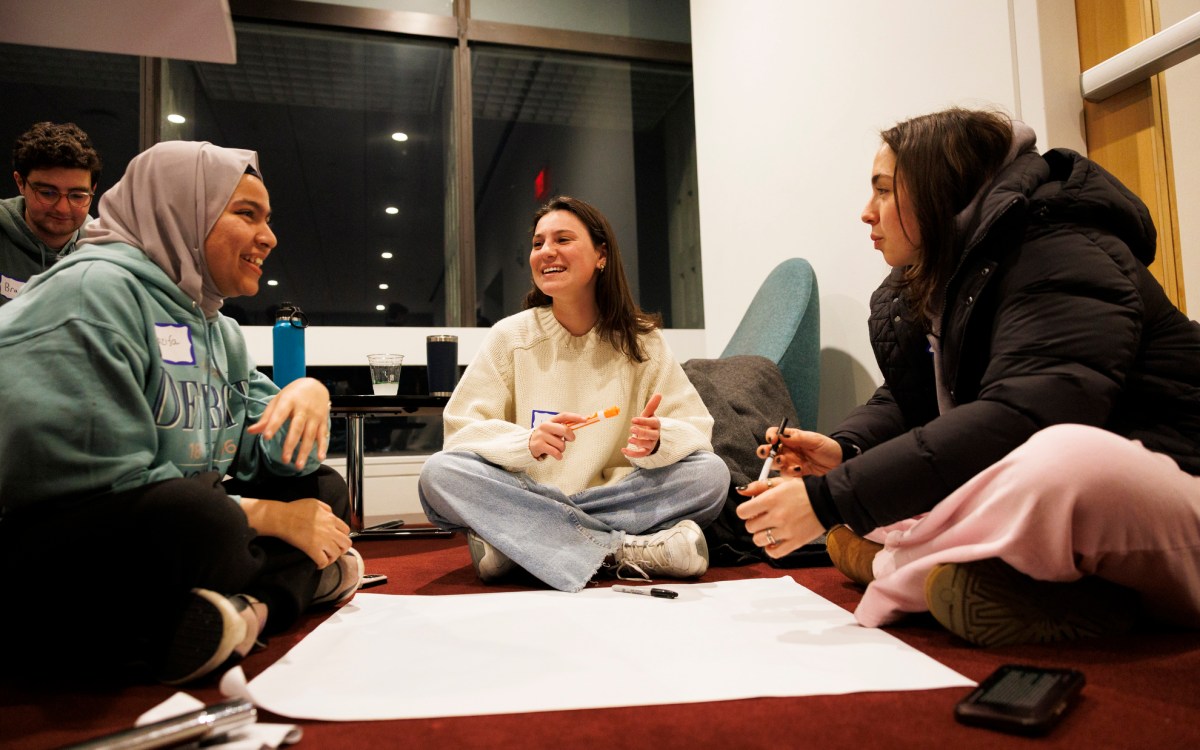Interfaculty Initiative helps clear the air

Anyone who has ever visited Beijing in winter knows that air pollution is one of the citys biggest problems. Homes, schools, offices all heat with coal which also is the major source of electrical energy. The result is a pall of black soot that settles into peoples lungs and bronchial tubes, and produces an annual epidemic of respiratory disease. The problem is repeated in many of Chinas industrial areas and population centers.
In the past, Chinese policy-makers have given only a modicum of attention to this issue. In a nation undergoing rapid development, it was believed that to divert funds away from industry or to force enterprises to clean up their emissions would only hold back progress. Such a policy, it was widely thought, would not be in the countrys best long-term interests, regardless of the health gains that might be made.
But what if it were possible to calculate the economic costs of air pollution? If Chinese officials knew how much their country was paying for air pollution in terms of days lost from work, hospitalizations, etc., wouldnt they be more motivated to do something about the problem?
This was the thinking of scholars involved in a large-scale interdisciplinary collaboration known as the China Project, which has been going on for approximately eight years. The China Project is part of the University Committee on Environment (UCE), which in turn is one of 10 Interfaculty Initiatives. These are programs that were identified in a University-wide planning effort to address areas that are important to society and can be explored only through collaboration across faculties.
The other nine initiatives are Health Policy, the Harvard Childrens Initiative, Mind/Brain/Behavior Initiative, the University Center for Ethics and the Professions, the Asia Center, the David Rockefeller Center for Latin American Studies, the Native American Program, the Hauser Center for Nonprofit Organizations, and the Center for International Development.
The China Project is a multidisciplinary research program on China’s energy use and environmental policies, and the role of these issues in Sino-American relations. The program explores integrated policy responses to greenhouse gas emissions by the world’s two leading national sources, the United States and China, and to the two issues of immediate concern to China: local and regional air pollution.
The team comprises more than 50 professors, researchers, and policy-makers at Harvard and in China. They cover a wide range of disciplines including atmospheric science, public health, engineering, economics, public policy, law, political science, anthropology, and business.
The program is co-chaired at Harvard by Michael McElroy, the Gilbert Butler Professor of Environmental Studies, and Xiping Xu, associate professor of occupational epidemiology in the Faculty of Public Health.
“One of the basic principles of the project was that we would work with China in a constructive way, not just blame them. That way, we would have a real impact,” Xu said.
In order to achieve the constructive results the team hoped for, an interdisciplinary approach proved to be a necessity. This requirement was especially true of the health evaluation project, the study that would provide a monetary figure for the health damage done by air pollution.
The first step in this study was to evaluate Chinas energy use and determine the quantity of air pollution produced by the burning of coal and other fossil fuels. Next, atmospheric scientists modeled the transport of these pollutants to understand where they ended up.
A study of the health impacts of these pollutants was the next step, followed by a survey, which sought to evaluate as accurately as possible the monetary value that the society placed on good health. Preliminary results of the health evaluation study show that the economic impact of air pollution works out to about 10 percent of gross national product, a figure that Xu thinks will help the Chinese to make more informed decisions about controlling atmospheric emissions. “I think they will see that controlling air pollution is actually a good investment.”
The response of Chinese officials to the health evaluation study and to the China Project in general has proved that the collaborative approach is working. Song Jian, a state counselor and chairman of the State Science and Technology Commission, came to Harvard in 1994 and expressed interest and support for the
Project.
“Having the backing of a state counselor was an enormous attention-grabber,” said Chris Nielsen, UCE executive director. “It infused our Chinese partners with a great deal of enthusiasm.”
More recently, at a workshop held this past January in conjunction with Tsinghua University in Beijing, Xie Zhenghua, the head of the Chinese Environmental Protection Agency, expressed enthusiasm for the project.
“He told us, I need to be briefed on this study as it progresses,” Nielsen said.
Navigating Aging
From the swirling gases of the atmosphere to the mysterious electrochemical processes of the brain may seem like an abrupt step, but here, too, the key to solving complex and urgent problems has proven to be research that cuts across interdisciplinary boundaries.
Mind/Brain/Behavior Initiative (MBB) brings together such divergent scholars as psychologists, molecular biologists, computer scientists, statisticians, animal behaviorists, and architects to investigate the effect of aging on the brains navigational skills. According to Neurology Professor Kenneth Kosik, a member of the working group on the aging brain, such diversity is typical of MBBs approach.
“Mind/Brain/Behavior is truly multidisciplinary in nature. Almost by necessity you must bring in people with very diverse expertise,” Kosik said.
The group began about a year ago. Pooling their expertise, the participants realized that in studying the problem of navigation they could bring together studies of both animals and humans, a strategy that promised to shed light on both.
A great deal of data had already been gathered on how animals find their way to food, how they migrate, reach spawning grounds, etc. Researchers wondered how aging might affect these abilities and how that process might compare with dementia in aging humans and the loss of ability to navigate in once-familiar environments.
“We wanted to find out what is the cellular basis for the aging phenomenon that affects navigational skills as we age,” Kosik said.
Kosik is studying how learning affects gene expression, or the “turning on” of genes. He hopes this research will reveal an actual genetic signature for memory, which will then allow him to explore how memory is affected by aging on the molecular level.
Working with him on this research is Assistant Professor of Psychology Mark Baxter. As a psychologist, Baxter has conducted research on learning in animals, but he has never had the opportunity to explore learning from the perspective of neurology and molecular biology. Participating in MBB has given him that opportunity.
“I would never have known about this work if not for MBB,” Baxter said. “Its had a significant impact on the way I think. Because of my association with Ken Kosik, Im working in the lab on the neuromechanisms of age-related cognitive decline. I was interested in gene expression, but I never had the opportunity to do it because I didnt know the methodology.”
The members of the working group credit MBB with having the foresight to provide the funding that helped this unusual collaboration get off the ground. Now the group is applying for a larger grant from National Institutes of Health that will allow them to pursue the research further. Kosik believes that this cross-disciplinary research will lead to insights that would not have been obtainable any other way.
“Theres a tendency in a university to interact mostly with your immediate colleagues,” he said. “You dont realize how much parallel thinking is going on about a given problem. We can make so much more progress if we can foster those interdisciplinary initiatives. I think its at these interfaces between fields where the real breakthroughs occur.”
Profiting From Nonprofits
As one of the newest of the Interfaculty Initiatives, the Hauser Center for Nonprofit Organizations still is in the process of finding those interfaces, of putting together the proper mix of scholars and facilitating their interaction in a way that will produce new breakthroughs.
Established in 1997, the Hauser Center for Nonprofit Organizations is headed by Mark Moore, the Daniel and Florence Guggenheim Professor of Criminal Justice and Policy Management. The Centers mandate is to increase the amount of scholarship on the nonprofit sector.
Moore had a taste of interdisciplinary collaboration when he was part of a MBB working group on inter-group violence. The experience introduced him to some of the problems that can occur when scholars of different disciplines sit down to address a common issue.
“I found that there was an astonishingly high degree of brilliance and imagination among that group,” Moore said. “But I also found that the clash of paradigms was huge. I found I had to start over and learn these subjects anew.”
Learning a new subject, or relearning it from an unfamiliar perspective can be difficult for scholars, Moore discovered.
“Its a hard thing for a faculty member to be naive and incompetent in an area, after developing expertise in his or her own area. It feels scary to go back to school, to have to learn the basics.”
But Moore has taken the lessons learned during his MBB experience and applied them to his fledgling Hauser Center. One of the Hauser Centers main endeavors is to develop working groups, which have acquired the title “Intellectual Foundations.” There are two of them, known as IF1 and IF2. The first is dedicated to looking at the nonprofit sector from a public policy perspective. The second seeks to define and understand the role of faith-based organizations.
Moore believes that simple things can sometimes hold the secret to effective collaboration. For example, he has found that round-table discussions by experts in various fields can help bring to light the important aspects of a subject. But such discussions will be of little avail unless they are accurately recorded and transcribed and subjected to careful analysis. Participants in a discussion, even if they take careful notes, cannot hear all the points that are made.
Another factor is what Moore calls “a sufficiently powerful holding environment that will hold people together when the work is painful to do and uncertain in its results.”
Equally important is having a smoothly working administrative staff that can get people to meetings at the same time and make sure the chairs are comfortable. Also key is simply whether people like each other.
Although the Hauser Center is still in the early stages of its cross-disciplinary research, Moores grasp of the essentials of effective collaboration bodes well for the future. Doubtless, it will be only a matter of time before the scholars who form these exploratory discussion groups find their way to what Kosik calls the “interfaces between fields where the real breakthroughs occur.”




